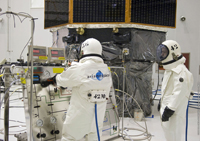Herschel spacecraft is fully fuelled
15 April 2009
The Herschel fuelling procedure has been successfully completed - the reaction control system tanks are now fully loaded with 256 kg of hydrazine liquid.The reaction control system (RCS) on the Herschel spacecraft is responsible for providing all the necessary forces and torques needed to change the angular momentum of the spacecraft. This is used to perform all in-orbit manoeuvres, including those for orbit transfer, insertion and maintenance, and for attitude control. The Herschel RCS includes two propellant storage tanks, two latch valves and a pressure transducer, and 12 thrusters (6 nominal plus 6 redundant). The fuel of choice for the thrusters is hydrazine.
Preparations for working with a highly toxic fluid
Hydrazine, N2H4, is a highly toxic and volatile fluid commonly used as rocket fuel. When it interacts with a catalyst, in this case a combination of aluminium and platinum built into the thrusters, the resulting reaction is highly exothermic and produces a large volume of gas from a small volume of liquid hydrazine making it an efficient thruster propellant.
Because of the dangerous nature of the fuel the hydrazine activities are carried out in one of several dedicated facilities (the S5B cleanroom) at the Centre Spatial Guyanais, by trained operators wearing protective garments known as "scape suits".
 |
|
The safety control room in S5C Credit: ARIANESPACE |
For the Herschel fuelling activities two operators worked during two days in two 5-hour shifts per day in the cleanroom, and were guided by colleagues who directed and monitored the operations from a safety control room located in the S5C area of the building complex. In addition to monitoring the activities on video screens from several remotely controlled cameras, the team in the control room could also check pressure and temperature levels, monitor the mass of hydrazine being loaded into the fuel tanks and record readings from hydrazine sniffer devices (to check for leaks).
An important part of the preparations for the fuelling activity was ensuring that the scape suits were adjusted properly, that air flow was correctly regulated and that the wireless communications between the fuelling operators and the control room personnel was functioning correctly.
 |
 |
 |
 |
|
Preparations for hydrazine fuelling in S5B | |
Once the operators were ready to enter the cleanroom the next step was to connect the spacecraft to the propellant and pressurant loading equipment which consists of several tanks filled with hydrazine hanging on a precision scales, valves and a vacuum pump system. The flow rates for the hydrazine filling were set and confirmed, and a one litre sample of the hydrazine was taken for analysis. This latter step is important as impurities in the fuel could impact on the performance of the thrusters in orbit.
For safety reasons, all non-essential spacecraft electrical equipment was removed from the S5B cleanroom and the remaining unused equipment was disconnected and wrapped in protective foil prior to starting the fuelling activities. The RCS tanks which had been filled with a slight overpressure of helium gas prior to start of the fuelling were emptied of helium and then, using Nitrogen, brought to the correct end-of-life pressure level before the hydrazine filling began.
Fully fuelled for a four year mission
Over the course of two days (10 -11 April) a total of 256 kg of hydrazine was loaded into the 2 reaction control system tanks. This is ample for all planned spacecraft manoeuvres for the 4-year mission. Once the full hydrazine load was achieved the tanks were closed off and the filling cart equipment was disconnected and removed from the fuelling hall together with the used fuelling drums. Once this had been completed and it was confirmed by measurements that the air contained no hydrazine traces, the cleanroom was opened again to normal use. One of the first activities then was to switch on the spacecraft to close latch valves in the RCS system that had to be open during the fuelling. The first switch-on of the spacecraft after fuelling is a hazardous operation performed fully remotely, with the complete building evacuated of personnel.
|
Above left: Herschel is raised over the platforms towards the launcher adapter |
The Herschel spacecraft was then raised from the fuelling position and moved to a location within the helium-filling platform system that had been installed last week where it was integrated with the launcher adapter ring (ACU).
The final stage after the fuelling operations is the additional off-line decontamination procedure which involves making sure that all equipment used during the fuelling is hydrazine-free at the level of 0.1 part-per-million before the equipment is packed, ready for shipment back to Europe.




